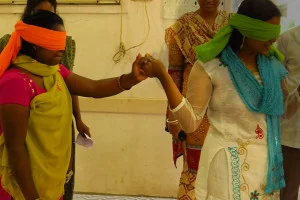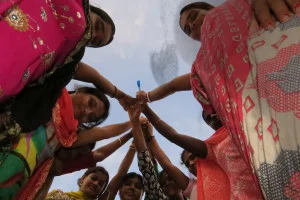Assertive claim to rights necessary to enliven a system
So much has been written about advocacy approaches used by people and organisations across the world. What Is common perhaps in all advocacy approaches is that it aims to capture the attention and gain favorable response from people who are power holders – bureaucrats, a senior official in an office or maybe a politician.So much has been written about advocacy approaches used by people and organisations across the world. What Is common perhaps in all advocacy approaches is that it aims to capture the attention and gain favorable response from people who are power holders – bureaucrats, a senior official in an office or maybe a politician.
When advocacy is led by the proletariat, they use walks, demonstrations and deputations as tools to express their opinion and assertion. When these efforts are organized and managed by NGOs, it often involves meetings, consultations, workshops or activities which are less confrontational, and aim to be persuasive.
Survivors of sexual exploitation are perhaps one of the most marginalized sections of people in the country, in any country. They are poor, women, less educated, often stigmatized in their own families and communities – a stigma which they often internalize and suffer from guilt and shame. They are dispersed geographically and therefore find it difficult to organize and collectivize, and in their own setting (family, community, village), they are always in the minority.
NGOs working with survivors of sexual exploitation have often raised concerns about how trading in children, women and men who are poor and landless, seems to be growing as a crime with impunity at an alarming rate. So, many of the asks from NGOs is about rescue of victims, prosecution of traffickers, monitoring of vulnerable children and women to prevent them from being lured, stricter laws.
What seems to have been NOT asked for by NGOs is a clear rehabilitation framework or policy in the states of India, or nationally. The Government of India formed a Central Advisory Committee to Address Commercial Sexual Exploitation of Women and Children more than a decade ago, one of its key tasks was to address issues of protection and rehabilitation of victims of sex trafficking. But that Committee was not successful in building clarity on what rehabilitation of survivors of sex trafficking would entail, what policies or directives need to be set in place to ensure that survivors of sex trafficking find appropriate and relevant services available and accessible.
Meanwhile, in South and North 24 Parganas in West Bengal, Partners in Anti Trafficking, a consortium of eight community based organizations, together with Goranbose Gram Bikash Kendra and Bansra Birangana Seva Samity, started working to combat human trafficking from 2006 in a more organized way, and found that strategies of prevention – collectivizing adolescent girls and building life skills, awareness campaigns in the communities, assisting families in registering missing complaints – all had limited impact in creating deterrence of the crime. Many of these organisations were also assisting survivors return to their families from Maharashtra, Delhi, Andhra Pradesh and Karnataka but felt helpless when they realized that survivors require help to combat with poverty, stigma and physical and psychological impacts of trafficking and that they had no resources (financial or technical) to provide services. Sanjog was confronted with the depths and severity of this deprivation in 2 researches – the first one was conducted in 2010 (Where Have All The Flowers Gone, Banerjee and Bandyopadhyay) and 2014 (Bringing it All Back Home, Sen, Dasgupta, Majumdar), and designed a community based rehabilitation intervention model to strengthen reintegration of survivors of sex trafficking in their families and communities, that was rights based.
The framework aimed to strengthen the assertion of survivors’ rights to reparation, recovery and rehabilitation through public services and strengthen roles of social workers as facilitators. The practice model trains social workers in enabling their clients to prioritize services they need, make formal claims from Panchayats, BDOs, health service providers, the police, Legal Aid Services authorities and other duty bearers, and when they do not find responses, move up hierarchy to reach the District Magistrates and take matters to court when required.
The approach shows an impressive increase in access to services, improvement in health, economic security and social assimilation of survivors, their empowerment and emerging leadership, increased support from their families and communities and reduction in stigma and prejudice. It also shows a more equitable relationship between social workers and their clients, improved levels of trust, reliance and mutual dependence – a distinct move from the savior-victim relationships that impair most anti trafficking interventions and harm rehabilitation programmes.
There are several lessons to be learnt from this intervention covering between 250 and 300 survivors, and 10 NGOs over the last 5 years.
1. It is natural for a social worker to carry unconscious prejudice towards a survivor of sex trafficking. Victims of sex trafficking are often seen as ‘unwilling sex workers’ – and therefore subjects of pity and sympathy. However, there is also an expectation that victims must be compliant, subdued, depressed, poor, always open to receiving help, obedient and always receive advice and be trusting towards NGOs and social workers who offer them help. When social workers encounter survivors, who are more aggressive, defiant, angry, mistrusting and manipulative (selective in receiving advise or help, withholding information that they know may not be well received by the social workers), they feel bewildered, angry and resentful. This is a phenomenon and not weakness of an individual or an organisation. Anti trafficking interventions need to factor that in and help social workers become more aware of their own stigma towards their clients.
2. The relationship between NGOs, Panchayats and the bureaucracy (BDOs, DSWOs, DMs) is hierarchical. Social workers often feel intimidated to be assertive, and try to persuade – and feel blocked confronted by an officer who does not respond favourably. Leaders and managers of such a programme need to invest in building assertion skills of social workers and help them use their resources – their anger, helplessness, their empathy for their clients in their engagement with power holders. Once they are able to challenge their own fear and helplessness, they find themselves more empowered and resourceful and are able to make the movement more robust.
3. What must be also challenged is the culture of NGOs, activists and social workers speaking on behalf of their clients, and for them. They must recognize that they are not to be the actors, the saviors. And in the case management planning, the role of their clients in making formal applications and being the formal claimant to services, on paper and on record, are absolutely critical for a robust evidence backed advocacy strategy. There is usually a doubt in the minds of NGOs (and we have found this even in the biggest of urban NGOs) that (a) survivors are disempowered, they cannot bear the responsibilities required to take a lead in claiming of their rights, and that the social worker or NGO must do it for them and (b) formal written claims by survivors will make officers in the bureaucracy and Panchayat members hostile and they will see this as an affront, especially when survivors in collectives approach the District Magistrates with evidence of failed responses, and this will impair the possibility of survivors ever receiving any services. Both these notions have proved to be untrue in this action
4. The progression of this movement becomes a transformative experience for individuals who are part of it, collectives organisations and the system as a whole. The increased responsiveness from Panchayat offices, or BDOs, the police or health service providers are symptoms of a change in values, attitudes, beliefs and practices of those individuals and their offices. West Bengal still does not have a rehabilitation policy but the bottom up, survivor-centred, rights based, assertive advocacy initiative has pushed the DM to be reactive, BDOs to be proactive and inventive in finding solutions within the existing system and resources. For example: to boost livelihood opportunities for survivors of trafficking, the district magistrate of North 24 Parganas instructed the District Social Welfare Office to draw up a proposal and submit it to the SRLM (State Rural Livelihood Mission). The Secretary of the SRLM and sanctioning office the NRLM was not convinced by the feasibility of creating SHGs of survivors or an individualized micro business approach. The DM’s office did not push the demand with the NRLM. Meanwhile, a BDO in one of the districts agreed to have an SHG with survivors of trafficking not restricted to a single Panchayat or village, but a group where members may have spread over a block. This example set 4 other BDOs to also adopt the measure – with an increased sense of confidence, responsibility and hope that this will increase financial inclusion of survivors of sex trafficking and aid in their rehabilitation. Needless to say, the process of formal applications and claims continuing, aggregation of data and using it to impress urgency to the system’s duty bearers is what keeps the system become solution centric and creative.
Team Sanjog
|
Tuesday
,
February 4, 2019


